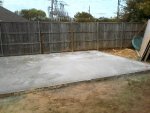What if we just poured a footer all around the outside of the pool where all the legs would be, do you think that would do the trick ?
That could work, although I think that would be a lot of extra work, digging the footer and added expense of the concrete.
Maybe a concrete pad at each leg. The pad would have to be at least 4 inches thick with a couple of inches of stone for the concrete to be poured on or you run the risk of it cracking.
The pavers will work they just have to sit on something that is compacted and won't settle. You could use two pavers set on top of each other, buried and flush with the ground. That may work also. ?



